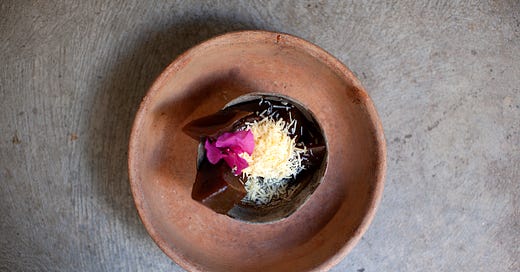In the town of Izamal, at the restaurant Kinich, in the northern Yucatán peninsula recently, I tasted a dulce de papaya, or candied papaya, that was far superior to any I’ve had before. It had a crunchy exterior, and soft, smoky interior, and was sprinkled with cinnamon and grated Edam cheese, as is customary in this part of Mexico. When I asked about what they did to it I understood why it was so good. Aside of the green papaya being cooked in sugar syrup with low heat over firewood for seven days, it was nixtamalized. It is what gave the papaya that contrasting crunchy smooth texture.
Usually when we think of nixtamalization, maíz is the ingredient we think of. Soaking dried corn kernels, as well as hominy, in an alkaline solution, generally water mixed with cal (calcium hydroxide or slaked lime), before cooking it makes the grains makes it more digestible and nutrients easier to absorb. It’s more nutritious, easier to turn into masa or flour and adds additional flavor. Yet, the process of nixtamalization can extend far beyond corn.
What they did at Kinich was not some new application of nixtamalization, but a typical one that has been widely applied to fruits like papaya or vegetables like squash for sweet recipes throughout the Americas. In Argentina and Uruguay, a similar preparation called zapallo en almíbar is traditionally prepared using cal viva, or calcium oxide (similar to calcium hydroxide) which gives it that crunchy smooth texture. There are several other similar recipes prepared using this technique, like dulce de calabaza in Mexico.
Elsewhere in the world, there are processes similar to nixtamalization that are used to imbibe flavors and textures to different foods. In ancient Rome, dough was often dipped in lye, another alkaline solution, before baking breads to making them softer and to last longer. In Spain, Italy and France lye is used to cure olives, while in Norway its used with cod to make lutefisk. In India winter melons are treated with calcium hydroxide to make a sweet called petha, while chickpeas are soaked in a baking soda solution to make curries.
Thinking beyond traditional applications of nixtamalization is mostly unexplored. Just as fermenting can reveal additional flavors and textures from various fruits and vegetables, nixtamalization can do the same. The restaurant Mugaritz in San Sebastian, Spain once made a nixtamalized banana tortilla, and has experimented with beets, Jerusalem artichokes and salsify. The Nordic Food Lab tried to use nixtamalization to make tortillas from Nordic grains. Increasingly I’ve seen chefs around the Americas nixtamalize root vegetables like carrots and beets, though it is still a relatively rare occurence.
With corn, the cal helps soften the kernels allowing the hard pericarp to loosen. With fruits and vegetables, it’s a little bit different. Not every fruit or vegetable will work. Those with lots of soluble fiber, or pectin, show the most effect. The calcium in the cal prevents the pectin from breaking down, helping it stay firm. With pumpkin and squash, the pectin is in the peel, as it is in fruits like papaya, cherries, plums, and peaches. You’ll also find it in apples, potatoes, carrots, peas and tomatoes. The nixtamalization process, which could be as quick as 30 minutes or as along as a dozen hours depending on the ingredient, adds a light coating, or crispness, on the outside to maintain shape while adding flavor and softened textures to the interior.
Keep reading with a 7-day free trial
Subscribe to New Worlder to keep reading this post and get 7 days of free access to the full post archives.




